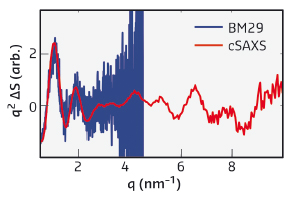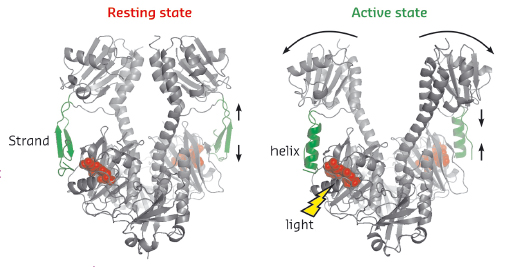- Home
- Users & Science
- Scientific Documentation
- ESRF Highlights
- ESRF Highlights 2014
- Structural biology
- Light-induced opening of a phytochrome
Light-induced opening of a phytochrome
All life on Earth is based on sunlight, and different organisms have developed multiple systems to detect and react to their light environment. Plants, bacteria, and several micro-organisms use light-sensitive proteins called phytochromes to control cellular functions in response to the changes in light. For example, a red/far-red light-absorbing bacterial phytochrome from Deinococcus radiodurans controls pigment production in response to light. The structures of several phytochromes have been solved in their resting state, but the structural details of their light activation have remained elusive [1]. Now, in a study conducted at the ESRF, the Swiss Light Source (SLS) and Advanced Photon Source (APS), we have assembled structural data on the activation mechanism of the phytochrome sensory module. These data provide exciting new insights into how light activates the protein. Our findings provide critical information for understanding these light-sensing proteins and set the basis for novel applications, e.g., in agriculture.
In the studies described here, we aimed to reveal the structural details of a bacterial phytochrome from D. radiodurans. To attain this, we compared X-ray solution scattering data of the resting and activated forms of the protein. The data involved small X-ray scattering (SAXS) data from the ESRF beamline BM29 and time-resolved solution X-ray data measured at SLS and APS in two states (Figure 96). This was achieved by switching the sample between the two states using flashes of different wavelengths of red light while the data were being collected. These SAXS data indicated large conformational changes in the protein upon activation.
 |
|
Fig. 96: Difference signals seen in light-induced SAXS (blue) and WAXS (red) scattering patterns from solutions of the phytochrome studied. The difference signals were calculated by subtracting the X-ray solution scattering pattern of the resting state from the solution scattering pattern of the active state and thus indicate structural changes between the states. |
After collecting the promising X-ray solution scattering data described above, we verified the exact structural changes between the states using X-ray crystallography. We managed to crystallise the photosensory module in two states: resting (Pr, red-absorbing) and active (Pfr, far-red absorbing) and collected diffraction data at ESRF beamline ID23-1. In both states the phytochrome appeared as a parallel dimer, as shown in Figure 97. However, the conformation of the dimers differed considerably between the states: the resting state adopts a “closed” configuration, the active state an “open” configuration in which the gap between the two subunits making up the dimer is opened by several nanometres.
 |
|
Fig. 97: Crystal structures of the resting and active state of the phytochrome fragment. The chromophore is shown in red and the tongue region of the protein is in green. The resting state was obtained by growing the crystals in complete darkness; the active state crystals needed sequential red light illumination to appear. |
In the structure of this phytochrome, an evolutionally highly conserved amino acid sequence forms a tongue-like structure (green in Figure 97). This tongue was shown to form a β-sheet structure in the resting state. Remarkably, the tongue adopted a completely different secondary structure in the activated state, taking up a shorter, α-helical conformation. The resulting shortening of the tongue by ~2.5 angstroms explain how the light-induced changes are relayed to the rest of the phytochrome protein, and finally to the next proteins in the signalling cascade.
Our results have led to a comprehensive picture of the light-induced activation of the phytochrome. First, red light causes small conformational changes in the chromophore (red in Figure 97), which are amplified and transmitted to the rest of the protein. The tongue region of the phytochrome rearranges and shortens, which forces changes in the relative orientations of the rigid protein domains, leading to “opening” of the entire dimer structure. In this way a tiny change induced by absorption of a photon is amplified to a dramatic conformational rearrangement of the protein.
This finding sets the ground for the development of phytochrome-based applications and further studies in the field of phytochrome research [2]. Our next goal is to decipher how the structural signal changes the biochemical activity of the output region of the protein, which ignites signalling cascades within the cell. Naturally, this requires collecting more structural data on phytochromes.
Principal publication and authors
H. Takala (a, b), A. Björling (b), O. Berntsson (b), H. Lehtivuori (a), S. Niebling (b), M. Hoernke (b), I. Kosheleva (c), R. Henning (c), A. Menzel (d), J.A. Ihalainen (a) and S. Westenhoff (b), Nature 509, 245-248 (2014).
(a) University of Jyväskylä, Jyväskylä (Finland)
(b) University of Gothenburg (Sweden)
(c) University of Chicago (U.S.)
(d) Paul Scherrer Institut, Villigen (Switzerland)
References
[1] A.T. Ulijasz and R.D. Vierstra, Curr Opin Plant Biol. 14, 498-506 (2011).
[2] A.W. Baker and K.T. Forest, Nature 509, 174-5 (2014).



